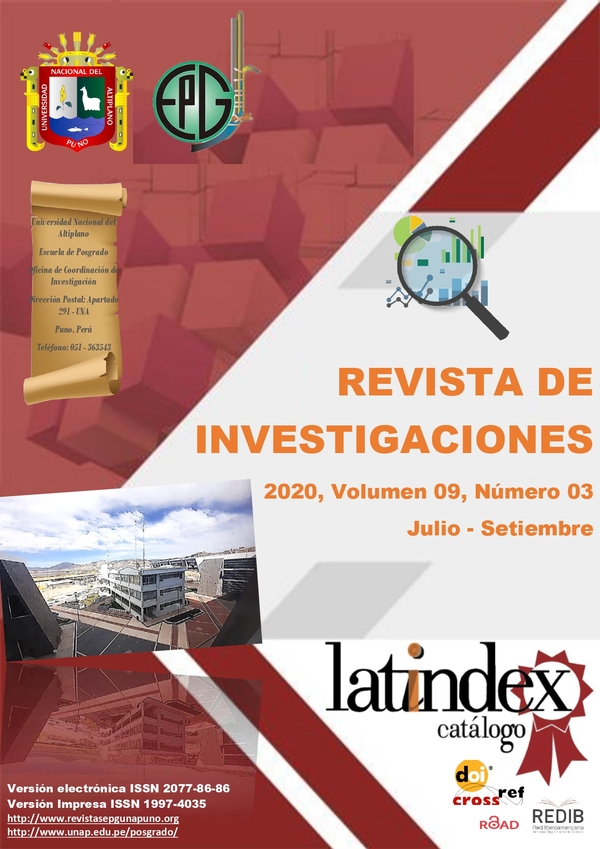CAPACIDAD DE BIODEGRADACIÓN DE Pseudomonas aeruginosa FRENTE AL POLIETILENO DE BAJA DENSIDAD
DOI:
https://doi.org/10.26788/riepg.v9i3.2027Palabras clave:
Bacteria, biodegradación, biopelícula, cepa, fluorescencia, medio mineral, polietilenoResumen
RESUMENLa biodegradación del polietileno de baja densidad por microorganismos, es una alternativa de solución para reducir la contaminación por plásticos; la investigación tuvo como objetivo evaluar la capacidad de biodegradación de Pseudomonas aeruginosa frente al polietileno de baja densidad; la bacteria fue aislada de residuos plásticos obtenidos del botadero de Cancharani de la ciudad de Puno, la identificación taxonómica se realizó en base a características macroscópicas de crecimiento en placa y el estudio microscópico empleando la tinción de Gram; la adaptación de la bacteria se realizó en un medio mineral con partículas de polietileno; la capacidad biodegradativa se determinó a temperaturas de 25 y 35 °C con un pH de 5,0 y 7,0, durante 30 días, obteniendo como resultados un porcentaje de 21,7 % y 27,3 % de pérdida de peso a una temperatura de 25 °C y 35 °C respectivamente a un pH de 7,0. Además, se evidenció la viabilidad de la biopelícula con microscopio de fluorescencia.
Descargas
Citas
REFERENCIAS
Acuña N. R. 2017. Revisión Bibliográfica sobre los Microorganismos Biodegradadores de Polietileno de Baja Densidad LDPE y sus Efectos en el Material [Universidad Distrital Francisco José de Caldas, Bogotá]. http://repository.udistrital.edu.co/handle/11349/5608
Anwar M., Negi H., Zaidi M., Haider G., Gupta S., Goel R. 2013. Biodeterioration studies of thermoplastics in nature using indigenous bacterial consortium. Brazilian Archives of Biology and Technology, 56(3), 475–484.https://doi.org/10.1590/S1516-89132013000300016
Apiplast 2012. Situación de la industria plástica en el Perú.
Begum N., Stephens, S., Schoeman O., Fraschke A., Kirsch B., Briere J.-B., Verheugt F. W. A., van Hout B. A. 2015. Cost-effectiveness Analysis of Rivaroxaban in the Secondary Prevention of Acute Coronary Syndromes in Sweden. Cardiology and Therapy, 4(2), 131–153. https://doi.org/10.1007/s40119-015-0041-3
Bhatia R., Ortega L., Dash A. P., Mohamed A. J. 2014. Vector-borne diseases in South-East Asia: burdens and key challenges to be addressed. WHO South-East Asia Journal of Public Health, 3(1), 2–4. https://doi.org/10.4103/2224-3151.115828
Cava F., de Pedro M. A., Lam H., Davis B. M., Waldor M. K. 2011. Distinct pathways for modification of the bacterial cell wall by non-canonical D-amino acids. The EMBO Journal, 30(16), 3442–3453. https://doi.org/10.1038/emboj.2011.246
Cava F., Hidalgo A., Berenguer J. 2009. Thermus thermophilus as biological model. Extremophiles : Life under Extreme Conditions, 13(2), 213–231. https://doi.org/10.1007/s00792-009-0226-6
Chavant P., Martinie B., Meylheuc T., Bellon-Fontaine M.-N., Hebraud M. 2002. Listeria monocytogenes LO28: surface physicochemical properties and ability to form biofilms at different temperatures and growth phases. Applied and Environmental Microbiology, 68(2), 728–737. https://doi.org/10.1128/AEM.68.2.728-737.2002
Cole M., Lindeque P., Fileman E., Halsband C., Goodhead R., Moger J., Galloway T. S. 2013. Microplastic ingestion by zooplankton. Environmental Science & Technology, 47(12), 6646–6655. https://doi.org/10.1021/es400663f
Das R. K., rar S. K. 2013. Plant mediated green synthesis: modified approaches. Nanoscale, 5(21), 10155–10162. https://doi.org/10.1039/C3NR02548A
Engler R. E. 2012. The complex interaction between marine debris and toxic chemicals in the ocean. Environmental Science & Technology, 46(22), 12302–12315. https://doi.org/10.1021/es3027105
Fontanella S., Bonhomme S., Brusson J. M., Pitteri S., Samuel G., Pichon G., Delort A. M. 2013. Comparison of biodegradability of various polypropylene films containing pro-oxidant additives based on Mn, Mn/Fe or Co. Polymer Degradation and Stability, 98(4 SRC-BaiduScholar FG-0), 875–884. https://doi.org/10.1016/j.polymdegradstab.2013.01.002
Gonzáles V. 2019. Capacidad biodegradativa de hongos filamentosos frente al polietileno. [Universidad Nacional del Altiplano]. http://repositorio.unap.edu.pe/handle/UNAP/12254
Greenpeace 2019. Plásticos en los océanos. Datos, comparativas e impactos. In Dosier de prensa Espaa Disponible en greenpeaceorg. www.greenpeace.org
Hadad D., Geresh S., Sivan A. 2005. Biodegradation of polyethylene by the thermophilic bacterium Brevibacillus borstelensis. Journal of Applied Microbiology, 98(5), 1093–1100. https://doi.org/10.1111/j.1365-2672.2005.02553.x
Huerta E. 2018. El plástico y su impacto ambiental. In El comercio Lima1httpselcomerciopetecnologiacienciascontaminacionplasticoimpactosaludnoticia541460. www.elcomercio.com.pe
Hussein A. A., Al-Mayaly I. K., Khudeir S. H. 2015. Isolation, Screening and Identification of Low Density Polyethylene (LDPE) degrading bacteria from contaminated soil with plastic wastes. Mesopotamia Environ J, 1(4 SRC-BaiduScholar FG-0), 1–14. https://www.iasj.net/iasj?func=article&aId=171203
Ishigaki T., Sugano W., Ike M., Fujita M. 2000. Enzymatic degradation of cellulose acetate plastic by Novel degrading bacterium Bacillus sp. S2055. Journal of Bioscience and Bioengineering, 90(4), 400–405. https://doi.org/10.1016/S1389-1723(01)80008-6
Ivleva N. P., Wiesheu A. C., Niessner R. 2017. Microplastic in Aquatic Ecosystems. Angewandte Chemie (International Ed. in English), 56(7), 1720–1739. https://doi.org/10.1002/anie.201606957
Jailawi M. H. A., Ameen R. S., Saraf A. A. A. 2015. Polyethylene degradation by Pseudomonas putida S3A. Int J Adv Res Biol Sci, 2(1 SRC-BaiduScholar FG-0), 90–97. https://www.researchgate.net/publication/283459113_Polyethylene_degradation_by_Pseudomonas_putida_S3A
Kannahi M., Sudha P. 2013. Screening of polythene and plastic degrading microbes from Muthupet mangrove soil. Pharm Res, 5(8), 122–127. www.jocpr.com
Koneman E. W., Allen S. 2008. Koneman. Diagnostico Microbiologico/Microbiological diagnosis: Texto En Color/Text and Color Atlas. https://books.google.com.pe/books/about/Koneman_Diagnostico_Microbiologico_Micro.html?id=jyVQueKro88C
Kumari K., Aanad R. C., Narula, N. 2009. Microbial degradation of polyethylene (PE). The South Pacific Journal of Natural and Applied Sciences. 27(1 SRC-BaiduScholar FG-0), 66–70. https://doi.org/10.1071/SP09012
Kyaw B. M., Champakalakshmi R., Sakharkar M. K., Lim C. S., Sakharkar K. R. 2012. Biodegradation of Low Density Polythene (LDPE) by Pseudomonas Species. Indian Journal of Microbiology, 52(3), 411–419. https://doi.org/10.1007/s12088-012-0250-6
Lee B., Pometto A. L., Fratzke A., Bailey T. B. 1991. Biodegradation of degradable plastic polyethylene by phanerochaete and streptomyces species. Applied and Environmental Microbiology, 57(3), 678–685. http://www.ncbi.n
Méndez C. R., Vergaray G., Béjar V. R., Cárdenas K. J. 2007. Aislamiento y caracterización de micromicetos biodegradadores de polietileno. Revista Peruana de Biologia, 13(3 SRC-BaiduScholar FG-0), 203–206. http://www.scielo.org.pe/pdf/rpb/v13n3/v13n03a08.pdf
Mumtaz T., ParvinNur H., Khan M. R., Bangladesh J. 2006. Susceptibility of low density polyethylene films to pond water microflora. Bot, 35(1 SRC-BaiduScholar FG-0), 31–37. https://www.researchgate.net/profile/Tabassum_Mumtaz/publication/255983611_Susceptibility_of_low_density_polyethylene_films_to_pond_water_microflora/links/0c96052144afe50212000000/Susceptibility-of-low-density-polyethylene-films-to-pond-water-microflora.p
Municipalidad Provincial de Puno 2019. Estudio de caracterización de residuos sólidos municipales del distrito de Puno-2019. www.munipuno.gob.pe
Nanda, S., Sahu, S., Abraham, J., & Sahu, S. S. 2010. Studies on the biodegradation of natural and synthetic polyethylene by Pseudomonas spp. Journal of Applied Sciences and Environmental Management, 14(2 SRC-BaiduScholar FG-0), 95–98. https://doi.org/10.4314/jasem.v14i2.57839
Nanda S., Sahu S. S. 2010. Biodegradability of polyethylene by Brevibacillus Pseudomonas and Rhodococcus spp. New York Science Journal, 3(7), 95–98. https://www.semanticscholar.org/paper/Biodegradability-of-polyethylene-by-Brevibacillus%2C-Nanda-Sahu/a33b3c8541c3387b2c27be1a2f68a43d1d529a2e
Ortiz H., Cuevas S., Coria J. 2004. Caracterizacin por RAPDPCR de aislados de Pseudomonas aeruginosa obtenidos de pacientes con fibrosis quistica. A F Prez F L R C, 46(2 SRC-BaiduScholar FG-0), 149–157. http://www.scielo.org.mx/scielo.php?script=sci_arttext&pid=S0036-36342004000200009
Paço, A., Duarte, K., da Costa, J. P., Santos, P. S. M., Pereira, R., Pereira, M. E., Freitas, A. C., Duarte, A. C., & Rocha-Santos, T. A. P. (2017). Biodegradation of polyethylene microplastics by the marine fungus Zalerion maritimum. The Science of the Total Environment, 586, 10–15. https://doi.org/10.1016/j.scitotenv.2017.02.017
Plastics Europe. 2010. Plastics. http://www.plasticseurope.org/Documents/Document/20100226115604- Full_Spain.pdf
Pramil R., Padmavathy K., Ramesh K. V, Mahalakshmi K. 2012. Brevibacillus parabrevis, Acinetobacter baumannii and Pseudomonas citronellolis-Potential candidates for biodegradation of low density polyethylene (LDPE). African Journal of Bacteriology Research, 4(1 SRC-BaiduScholar FG-0), 9–14. https://doi.org/10.5897/JBR12.003
Rajandas H., Parimannan S., Sathasivam K., Ravichandran M., Yin L. S. 2012. A novel FTIR-ATR spectroscopy based technique for the estimation of low-density polyethylene biodegradation. Polymer Testing, 31(8 SRC-BaiduScholar FG-0), 1094–1099. https://doi.org/10.1016/j.polymertesting.2012.07.015
Ren J., Lin W. T., Shen Y. J., Wang J. F., Luo X. C., Xie M. Q. 2018. Optimization of fermentation media for nitrite oxidizing bacteria using sequential statistical design. Bioresource Technology, 99(17), 7923–7927. https://doi.org/10.1016/j.biortech.2008.03.027
Revelles O., Espinosa-Urgel M., Fuhrer T., Sauer U., Ramos J. L. 2005. Multiple and interconnected pathways for L-lysine catabolism in Pseudomonas putida KT2440. Journal of Bacteriology, 187(21), 7500–7510. https://doi.org/10.1128/JB.187.21.7500-7510.2005
Romero S. E. G., Bustos D. C. G., Casallas M. L., Vargas P. C. M. 2008. Factores bióticos y abióticos que condicionan la biorremediación por Pseudomonas en suelos contaminados por hidrocarburos. Nova, 6(9 SRC-BaiduScholar FG-0), 76–84. https://doi.org/10.22490/24629448.398
Ruíz M. L. 2007. Pseudomonas aeruginosa: Aportación al conocimiento de su estructura y al de los mecanismos que contribuyen a su resistencia a los antimicrobianos [Universidad de Barcelona]. http://diposit.ub.edu/dspace/handle/2445/42532
Seymour R. B. 1899. Polymer science before and after : notable developments during the lifetime of Maurits Dekker. Journal of Macromolecular ScienceChemistry, 26(8 SRC-BaiduScholar FG-0), 1023–1032. https://doi.org/10.1080/00222338908052032
Shah S. R., Najim N. I., Shahnawaz W., Jangda A. A. 2019. Comments on: “High ankle-brachial index and risk of cardiovascular or all-cause mortality: A meta-analysisâ€. Atherosclerosis, 284, 267. https://doi.org/10.1016/j.atherosclerosis.2018.12.028
Shalini S., Dorstyn L., Dawar S., Kumar, S. 2015. Old, new and emerging functions of caspases. Cell Death and Differentiation, 22(4), 526–539. https://doi.org/10.1038/cdd.2014.216
Singh J., Gupta, K. C., Shrivastava A. 2015. Isolation and identification of low density polyethylene (LDPE) degrading bacterial strains from polythene polluted sites around GWALIOR CITY (M.P.). Journal of Global Biosciences, 4(8 SRC-BaiduScholar FG-0), 3220–3228. https://www.mutagens.co.in/jgb/vol.04/8/040829.pdf
Skariyachan S., Megha M., Kini M. N., Mukund K. M., Rizvi A., Vasist K. 2015. Selection and screening of microbial consortia for efficient and ecofriendly degradation of plastic garbage collected from urban and rural areas of Bangalore, India. Environmental Monitoring and Assessment, 187(1), 4174. https://doi.org/10.1007/s10661-014-4174-y
Tellez A. 2004. La complejidad de la problemática ambiental de los residuos plásticos: una aproximación al análisis narrativo de política pública en Bogotá (Vol. 304, Issues 5672 SRC-BaiduScholar FG-0) [Universidad de Bogotá]. http://bdigital.unal.edu.co/7080/1/905077.2012.pdf
Thompson R. C., Olsen Y., Mitchell R. P., Davis, A., Rowland S. J., John A. W., Russell, A. E. (2004). Lost at sea: where is all the plastic? Science, 304(5672), 838–838. www.sciencemag.org/cgi/content/full/304/5672/838/%0ADC1
Tokiwa Y., Calabia B. P., Ugwu, C. U., Aiba S. 2009. Biodegradability of plastics. International Journal of Molecular Sciences, 10(9), 3722–3742. https://doi.org/10.3390/ijms10093722
Tribedi P., Gupta A. D., Sil A. K. 2015. Adaptation of Pseudomonas sp. AKS2 in Biofilm on Lowdensity Polyethylene Surface an Effective Strategy for Efficient Survival and Polymer Degradation Bioresources and Bioprocessing 14, 2(1 SRC-BaiduScholar FG-0). https://doi.org/10.1186/s40643-015-0044-x
Tribedi P., Sil A. K. 2013. Low-density polyethylene degradation by Pseudomonas sp. AKS2 biofilm. Environmental Science and Pollution Research International, 20(6), 4146–4153. https://doi.org/10.1007/s11356-012-1378-y
Wu T., Jahan S. A., Zhang Y., Zhang J., Elmounayri H., Tovar, A. 2017. Design optimization of plastic injection tooling for additive manufacturing. Procedia Manufacturing, 10, 923–934. https://doi.org/10.1016/j.promfg.2017.07.082
Yang J., Yang Y., Wu W.-M., Zhao J., Jiang L. 2014. Evidence of polyethylene biodegradation by bacterial strains from the guts of plastic-eating waxworms. Environmental Science & Technology, 48(23), 13776–13784. https://doi.org/10.1021/es504038a
Publicado
Versiones
- 2022-05-17 (3)
- 2020-08-11 (2)
- 2020-08-11 (1)
Cómo citar
Número
Sección
Licencia
Derechos de autor 2020 Sandra Beatriz Butron Pinazo

Esta obra está bajo una licencia internacional Creative Commons Atribución 4.0.














